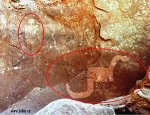GodIsSalvation said:
This one comes from the Dragon-Ishtar Gate which was supposedly created sometime during the Neo Babylonian time (same area as Sumer, or present day Iraq.) Obviously the fact it is called the dragon gate alone is good proofs of what this is.
I've heard it called the Ishtar Gate, but never the Dragon Gate. Perhaps I am not reading the same sources as you? When I did an Internet search using the term
Dragon Gate I found nothing (except for some Chinese restaurants), but the term
Ishtar Gate brings us right there. I suppose if you travel in certain circles that believe in dragons you might know it as the Dragon Gate, eh?
The mythological hybrid you have identified as a dragon was called Mušhuššu by the Babylonians. It was the sacred animal of the god Marduk and his son Nabi. If you are unfamiliar with mythological hybrids do a search on Wikipedia for Mythological Hybrids. These are “mythological creatures combining body parts of more than one real species.” This is not a dragon, GodIsSalvation. It has the head of a snake, the front legs and paws of a cat (probably a lion), and the hind legs and feet of a bird (possibly an eagle). It is a mishmash of the various body parts of extant animals.
Now, if you want to play at cryptozoology you could identify the torso and neck of the creature as belonging to a large animal called Sivatherium which is identified in science as belonging to the giraffe family. It ranged from Africa through the Middle East to India and is thought to have become extinct some 8,000 years ago, but who knows. It is known from rock paintings in the Sahara and perhaps a pocket of these creatures survived until historical times and served as the model for Mušhuššu. Oh, have you noticed that Sivatherium had horns on its head not totally dissimilar to those of Mušhuššu? Perhaps this observation completes the puzzle?
GodIsSalvation said:
This gate was removed and is now supposed to be in Germany.
It is in a museum in Berlin, Germany.
GodIsSalvation said:
And before anyone says it is a cat or whatever, one will note there are very distinct pictures of lions, aurochs, and such animals on the gate as well for you to compare.
So you think that because the lions and aurochs are portrayed accurately then the depiction of Mušhuššu must also be accurate. Well, I would say it is an accurate depiction Mušhuššu, the sacred animal of the gods Markuk and Nabi. The presence of Mušhuššu on the gate identifies the city as under the protection of Marduk, “the chief god of Babylon, who became lord of the gods of heaven and earth after conquering Tiamat, the monster of primeval chaos.” (ODE)
Any doubts?


